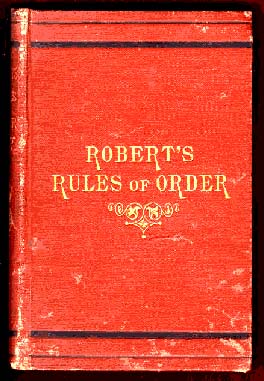
Robert's Rules of Order, often simply referred to as Robert's Rules, is a manual of parliamentary procedure by U.S. Army officer Henry Martyn Robert. "The object of Rules of Order is to assist an assembly to accomplish the work for which it was designed [...] Where there is no law [...] there is the least of real liberty." The term Robert's Rules of Order is also used more generically to refer to any of the more recent editions, by various editors and authors, based on any of Robert's original editions, and the term is used more generically in the United States to refer to parliamentary procedure. It was written primarily to help guide voluntary associations in their operations of governance.

In parliamentary procedure, a point of order occurs when someone draws attention to a rules violation in a meeting of a deliberative assembly.

A committee or commission is a body of one or more persons subordinate to a deliberative assembly or other form of organization. A committee may not itself be considered to be a form of assembly or a decision making body. Usually, an assembly or organization sends matters to a committee as a way to explore them more fully than would be possible if the whole assembly or organization were considering them. Committees may have different functions and their types of work differ depending on the type of organization and its needs.
In parliamentary procedure, an adjournment ends a meeting. It could be done using a motion to adjourn. A time for another meeting could be set using the motion to fix the time to which to adjourn.

Minutes, also known as minutes of meeting, protocols or, informally, notes, are the instant written record of a meeting or hearing. They typically describe the events of the meeting and may include a list of attendees, a statement of the activities considered by the participants, and related responses or decisions for the activities.
A repeal is the removal or reversal of a law. There are two basic types of repeal; a repeal with a re-enactment is used to replace the law with an updated, amended, or otherwise related law, or a repeal without replacement so as to abolish its provisions altogether.
In parliamentary procedure, unanimous consent, also known as general consent, or in the case of the parliaments under the Westminster system, leave of the house, is a situation in which no member present objects to a proposal.
A parliamentary authority is a book of rules for conducting business in deliberative assemblies. Several different books have been used by legislative assemblies and by organizations' deliberative bodies.
In US parliamentary procedure, the previous question is generally used as a motion to end debate on a pending proposal and bring it to an immediate vote. The meaning of this specialized motion has nothing to do with any question previously considered by the assembly.
In parliamentary procedure, an objection to the consideration of a question is a motion that is adopted to prevent an original main motion from coming before the assembly. This motion is different from an objection to a unanimous consent request.
In parliamentary procedure, the motion to postpone indefinitely is a subsidiary motion used to kill a main motion without taking a direct vote on it. This motion does not actually "postpone" it.
In parliamentary procedure, a motion to appeal from the decision of the chair is used to challenge a ruling of the chair.
In parliamentary procedure, a motion is a formal proposal by a member of a deliberative assembly that the assembly take a particular action. These may include legislative motions, budgetary motions, supplementary budgetary motions, and petitionary motions.
In parliamentary procedure in the United States, a motion to postpone to a certain time is used to delay action on a pending question until a different day, meeting, hour or until after a certain event. Then, when that time comes, the consideration of the question is picked up where it was left off when it was postponed.
Debate in parliamentary procedure refers to discussion on the merits of a pending question; that is, whether it should or should not be agreed to. It is also commonly referred to as "discussion".
In parliamentary procedure, requests and inquiries are motions used by members of a deliberative assembly to obtain information or to do or have something done that requires permission of the assembly. Except for a request to be excused from a duty, these requests and inquiries are not debatable nor amendable.
Parliamentary procedure is the body of rules, ethics, and customs governing meetings and other operations of clubs, organizations, legislative bodies, and other deliberative assemblies. General principles of parliamentary procedure include rule of the majority with respect for the minority.
In parliamentary procedure, the verb to table has the opposite meaning in the United States from that of the rest of the world:
According to Robert's Rules of Order, a widely used guide to parliamentary procedure, a meeting is a gathering of a group of people to make decisions. This sense of "meeting" may be different from the general sense in that a meeting in general may not necessarily be conducted for the purpose of making decisions.



